Microdosing cannabis is getting a lot of buzz lately for its potential cancer-fighting superpowers. It turns out that THC and CBD may thwart tumor growth, prevent cancer from spreading, and even help patients find relief from the side effects of conventional cancer treatments.
On the topic of cannabis and kidney cancer, “Mendelian randomization demonstrated a potential causal effect of cannabis use on a lower incidence of renal cell carcinoma.” (Huang, et. al.). In other words, cannabis seems to fight kidney cancer.
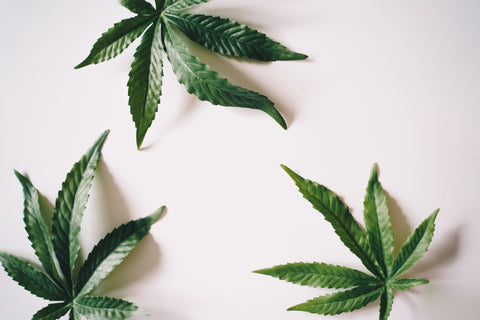
Now, you may think more is better, but not when it comes to cannabis. Lower doses of cannabis may just have the biggest anticancer benefits.
Our edibles are infused with low doses of THC, CBD, and other cannabinoids that cause no unwanted effects—just a multitude of health benefits.
Check out our selection of THC gummies and find out why they’re so powerful at kicking cancer to the curb.
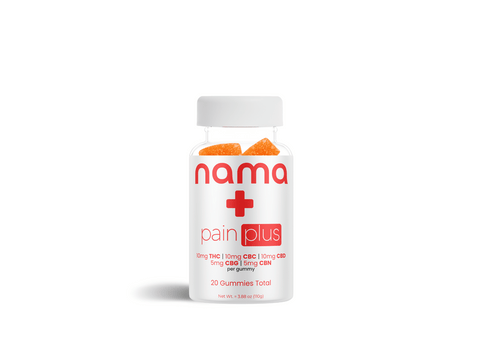
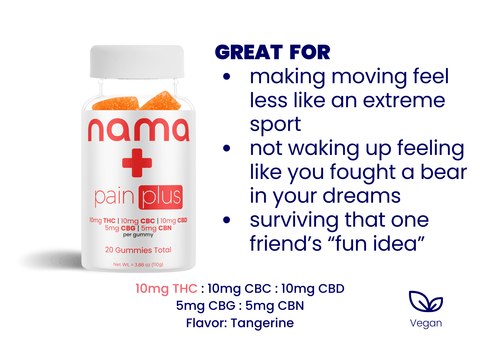
THC: 10 mg | CBC: 10 mg | CBD: 10 mg | CBG: 5 mg | CBN 5mg
What Is Kidney Cancer?
Kidney cancer is a type of cancer that causes healthy kidney cells to grow uncontrollably and form a tumor. These abnormal cancer cells multiply rapidly, forming a mass or lesion in the small tubes of the kidney where urine collects and drains. As the tumor grows, it can spread into the surrounding kidney tissue and eventually other parts of the body.
The most recent estimates by the American Cancer Society for kidney cancer suggest that around 80,000 new cases will be diagnosed in 2023 alone.
Also known as renal cancer, this disease is cunning and insidious. To understand it better, we need to shed light on the crucial functions of our kidneys and how damaging kidney cancer can be.
Why Are Kidneys So Important?
Our kidneys are two bean-shaped organs located on either side of the spine, behind the abdomen. They perform vital roles in cleansing, hormonal regulation, and homeostasis.
Let’s look at all the functions performed by our kidneys.
- Kidneys are involved in hormone release. Erythropoietin stimulates red blood cell production, renin regulates blood pressure, and calcitriol controls calcium levels for bone health.
- They contain over 1 million nephrons that act as filtering units, removing waste products, toxins, and excess fluid. This cleansing of the blood is vital to regulate levels of salts, minerals, and acids and to maintain fluid balance.
- They regulate blood pressure by modulating fluid volume and producing renin.
- Kidneys also filter blood. Each day, they filter around 40 gallons of fluid from the bloodstream, which produces 1–2 quarts of excreted urine.
- They help maintain the body's normal, slightly alkaline pH balance (7.4) by excreting acids and reabsorbing bicarbonate.
- Kidneys are involved in careful regulation of electrolyte levels in the body, including:
- Sodium, which controls blood pressure and nerve and muscle function
- Potassium, critical for nerve transmission and muscle contraction
- Calcium, which is needed for bone health and normal cellular processes
- Phosphate, which is required for bone formation and cell repair
Their diverse responsibilities help create the ideal environment for cells and enable normal functioning. Interfering with these functions threatens our overall health, and that’s exactly what kidney cancer does.
Kidney cancer often arises in the small tubes where urine collects and drains out of the kidneys. As tumors grow, they can impede the organ's complex filtration mechanisms. This allows waste, fluids, and electrolytes to build up to dangerous levels in the body.
Kidney cancer also undermines the organ's hormone production. Anemia, high blood pressure, bone disease, and other problems may result. Advanced cancer patients often experience kidney failure.
What Are the Symptoms of Kidney Cancer?
In its early stages, kidney cancer often has no symptoms that would raise red flags. It is not until the cancer advances—or is caught incidentally through tests for other abdominal conditions—that telltale signs begin to appear. Even then, they can be mistaken for other, less serious ailments.
However, in the terminal stages of metastatic kidney cancer, the symptoms of renal cancer can dramatically impact the patient’s quality of life. As the tumor enlarges, it can cause the following symptoms:
- Blood in the urine
- Abdominal pain
- An abdominal mass
- Fatigue
- Weight loss
- Fever
- High blood pressure
- Leg swelling
Kidney cancer is an insidious disease that progresses stealthily before signs emerge. Early detection and treatment are key because small tumors resolved surgically may spare patients grueling late-stage symptoms and prevent them from spreading to other organs (metastasis).
What Are the Types of Kidney Cancer?
There are several types of kidney cancer.
- Renal cell carcinoma (RCC) is the most common type of kidney cancer in adults, accounting for 90% of cases. It develops in the lining of tiny tubes within the kidneys (proximal convoluted tubules) that filter blood and remove waste. RCC metastasizes early, most often to lungs, lymph nodes, bones, liver, and brain. There are several subtypes of renal cell carcinoma based on appearance under a microscope:
- Clear cell RCC is the most common subtype and often the most aggressive. The cancer cells appear very pale or clear.
- Papillary RCC have the look of finger-like microscopic projections. This subtype accounts for 10–15% of all RCCs, grows more slowly, and has a higher and more effective treatment success rate.
- Chromophobe RCC is the least likely to spread and infect other organs. The cancer cells are dark brown or orange.
- Transitional cell carcinoma (TCC) develops in transitional epithelial cells that line the renal pelvis and ureter. The renal pelvis is the funnel-shaped structure in the kidney where urine collects before draining to the ureter. This type of kidney cancer is less common, accounting for 5–10% of kidney cancers, and it resembles bladder cancer under a microscope. TCC is typically less aggressive than RCC, but it can still metastasize and recur.
- Wilms tumor is a rare kidney cancer that affects children, typically under age 5. It is believed to arise from immature fetal kidney cells that abnormally activate. Luckily, Wilms tumors are more treatable than adult kidney cancers and have a 90% survival rate if detected early.
What Causes Kidney Cancer?
Kidney cancer is caused by damage to the genes of kidney cells, which makes them grow and divide uncontrollably. This abnormal behavior in the cells ultimately creates a tumor.
The exact causes of why this happens are not fully understood, but there are certain potential causes linked to kidney cancer development:
- Smoking is the number one risk factor. Chemicals in tobacco smoke can significantly damage kidneys. Smokers are 2–3 times more likely to get kidney cancer.
- If you’re overweight, your kidney cancer risk increases by up to 34%. Obesity can change hormone levels and lead to inflammation, which negatively affects kidney cells.
- Exposure to certain chemicals like asbestos, cadmium, benzene, organic solvents, and trichloroethylene seems to raise risk, especially with long-term exposure.
- Genetic and medical factors like family history and Von Hippel-Lindau disease (a rare inherited disorder caused by a mutation in the VHL tumor suppressor gene) increases the risk of developing kidney cancer.
- Patients on long-term dialysis have higher kidney cancer rates.
- Renal sclerosis might contribute to the development of kidney cancer. This condition involves the gradual hardening and scarring of the small blood vessels inside the kidneys, which damages the kidney tissues over time and can potentially lead to the formation of renal cell carcinoma.
- High blood pressure is linked to increased risk, possibly from kidney damage over time.
- The risk of getting kidney cancer rises as people get older, with most cases occurring in people 55–84.
- Kidney cancer is about twice as common in men as in women, but the reasons are still unclear.
Other possible factors include hepatitis C infection, excessive use of over-the-counter painkillers, and high calcium levels.
How Is Kidney Cancer Treated?
Kidney cancer is typically treated with conventional cancer treatments.
- Localized kidney cancer is often treated first with surgery to remove part or all of the affected kidney (nephrectomy).
- If cancer has spread to lymph nodes or other organs, doctors may employ additional treatments, such as targeted therapy drugs, to inhibit growth factors that promote cancer growth and blood vessel formation.
- Immunotherapy is used to stimulate the immune system to attack cancer cells.
- Radiation therapy uses high energy beams to destroy tumors.
- Chemotherapy is less commonly used for kidney cancer.
Kidney cancer can be highly aggressive if not detected early. Its severity often leads to equally aggressive treatments that come with loads of side effects. Some patients with cancer are seeking complementary medicine approaches. One such example is microdosing cannabis.
Small doses of THC and CBD alleviate many unpleasant side effects of chemotherapy and other cancer treatments, such as chronic pain, nausea, and appetite loss, while also potentially exhibiting anti-cancer effects. The key is keeping doses low to maximize benefits and limit side effects.
We’re about to explain the extraordinary benefits of low-dose cannabis in treating cancer, and you don’t want to miss it.
What Anticancer Properties Does Cannabis Have?
A 2022 systematic review and meta-analysis shed light on the anticancer properties of cannabis. The researchers found that THC and cannabidiol have:
- Anti-proliferative properties: cannabis inhibits the growth and division of cancer cells.
- Pro-apoptotic effects: cannabinoids such as Delta 9 and CBD cause programmed cell death (apoptosis) in cancer cells.
- Pro-autophagic effects: cannabis compounds promote autophagy, a process where cells degrade and recycle components, which can lead to cancer cell death.
- Anti-invasive effects: cannabis inhibits the spread and migration of cancer cells into surrounding tissues.
- Antimetastatic properties: cannabis helps prevent the metastasis, or spread, of cancer from the primary tumor site to other areas of the body.
- Anti-angiogenic effects: cannabis blocks the formation of new blood vessels (angiogenesis) that supply oxygen and nutrients to the tumor.
The review also highlights the importance of the endocannabinoid system (ECS) in defending the body against tumors, making it a promising target for anticancer interventions.
Now might be a good time to read our in-depth guide to Delta 9 THC and learn all about its mighty effects and benefits.
How Does The ECS Fight Cancer?
The endocannabinoid system is a complex network of signals and receptors that regulate a wide range of bodily functions. It is made up of endocannabinoids, enzymes that break them down, and cannabinoid receptors.
While our bodies naturally produce endocannabinoids, phytocannabinoids found in plants like cannabis interact with our ECS in the same way. They bind to the endocannabinoid receptors and influence pain management, sleep, appetite, the immune response, and many other biochemical changes in the body. By targeting the ECS, the role of cannabinoids is to slow tumor growth.
Delta 9 has a similar structure to the endocannabinoids and binds strongly to cannabinoid receptors, specifically CB1 and CB2 receptors. This binding triggers cellular responses that produce diverse effects in the body. When taken at sufficient doses, Delta 9’s interaction with CB1 receptors produces the “high” traditionally associated with THC.
Low amounts of THC do not have the psychoactive effects that normally occur with smoked cannabis or other forms of consumption. Find out why gummies are the healthiest way to microdose cannabis.
Many of our CBD products contain low doses of THC. Ten milligrams of Delta 9 paired with ten milligrams of CBD in our tasty Euphoria gummies will give you a mild euphoric experience while relieving pain and anxiety—all the while exerting the powerful antitumor effects of cannabinoids.
Find out why the effects of THC and CBD make such a good combo.
Product QUIZ
Need help deciding what product is best for you? Take our quiz, just three questions until your perfect match!
Is the Entourage Effect Good for Treating Cancer?
CBD and THC are two distinct compounds from the cannabis plant with different impacts on the ECS.
THC and CBD have equally potent medicinal effects. The combination of these two cannabinoids has greater therapeutic potential than each cannabis compound in isolation.
There’s actual science behind this synergistic interaction. It’s called the entourage effect.
In the entourage effect, cannabinoids work together to enhance each other's benefits. They act synergistically with each other, so CBD appears to heighten the effects of THC and vice versa. Some people don’t believe that the entourage effect is a real thing, but the evidence is obvious.
…CBD displays an entourage effect (the mechanism by which non-psychoactive compounds present in cannabis modulate the overall effects of the plant), and is capable of improving tolerability and perhaps also the safety of THC by reducing the likelihood of psychoactive effects and antagonizing several other adverse effects of THC (sedation, tachycardia, and anxiety). (Vučković, et. al.)
We think the best way to experience the entourage effect is with our full spectrum CBD products. Full spectrum CBD employs the benefits of both THC and CBD to achieve its medicinal effects and double its potency. You can also try our THC-free edibles, but where’s the fun in that? The entourage effect is proven to bring more benefits and much more cancer-related relief.
The effects of full spectrum CBD gummies can vary greatly from person to person. If you’re a beginner at microdosing, start by taking lower amounts—1 to 2 mg per gummy—and work your way up. For more experienced users, 5 mg of THC is a good place to start.
If you want to experience the harmonious marriage of THC and CBD, order our Relax Plus gummies. These easy-to-dose edibles provide the perfect balance of cannabinoids that help you regulate your mood, manage stress, and promote sleep while simultaneously showing cancer cells what’s up.
Can Cannabis Treat Kidney Cancer?
Cannabis boasts some powerful anticancer effects that may potentially apply to kidney cancer too. We saw how cannabis may stop cancer cells in their tracks, prevent tumor cells from growing, and even help our bodies obliterate them. So far, this research has mainly focused on cancers like breast, prostate, and lung.
Read more about the powerful ways in which THC and CBD fight prostate cancer.
A 2017 systematic review confirmed that cannabis shows many helpful activities, like increasing appetite, reducing nausea, and relieving chronic pain in patients with cancer. Cannabinoids were also studied for their therapeutic potential in slowing down the growth of tumors in urological cancers, which include kidney, prostate, bladder, and testicular cancers.
According to the review, a number of laboratory studies explain how cannabinoids might work against urological cancers. However, they haven’t found any clinical trials to confirm the association between cannabis use and reduced risk of kidney cancer in humans.
To date, there are various in vitro studies elucidating the potential mechanism of action of cannabinoids for urological cancers, along with population-based studies specifically for testicular malignancies. To date, no clinical trials have been conducted for urological cancer patients. (Gandhi, et. al.)
Here’s what the review had to say about the effects of cannabis on renal cancer:
Researchers found that kidney tumors have CB1 receptors and quoted Larrinaga, et. al. who “demonstrated that renal tumour tissues [are] expressed mRNA of CB1 receptor in the tubular system of adult kidneys." This suggests that the ECS might have a crucial role in fighting kidney cancer.
- “...CB1 receptor loss can potentially enhance the proliferation ability of tumour cells due to lack of antitumoural effect of endocannabinoids.”
Similarly, when CB1 receptors are less active (down-regulated), it might make clear-cell kidney tumors grow faster.
"CB1 is highly expressed in proximal convoluted tubules of the nephron, a similar concept may apply to renal neoplasms, where CB1 down-regulation may play a role in increased proliferation renal tumours, specifically clear-cell renal cell carcinomas.”
- These CB1 receptors could be valuable for developing new treatments for kidney cancer and might even help doctors diagnose different types of kidney tumors more accurately.
- "The receptors could not only play an important role in investigating treatment options, but could also be used for diagnostic purposes."
You may be interested in hearing all about how cannabinoids help fight bladder cancer. While there’s good reason to think cannabis could help knock out kidney cancer cells too, more kidney cancer-specific research is still needed to confirm these effects.
One thing is certain: low doses of cannabis may alleviate the potential adverse side effects of many types of cancer treatment, like chemotherapy and radiation therapy. A 2021 study revealed that advanced cancer patients regularly use cannabis to treat both cancer- and therapy-specific symptoms, such as:
- Chronic pain
- Nausea and vomiting
- Fatigue
- Poor appetite
- Anxiety and depression
- Brain fog
- Sleep problems
- Digestive problems
If you’re struggling with insomnia, anxiety, or cancer-related pain, our Sleep Plus gummies are an obvious choice. 25 mg of CBD and an ultra-low dose of THC (2 mg per gummy) work together to promote a healthy 8-hour-sleep every night and bring your body to a complete state of relaxation.
This unique blend also contains 3mg of melatonin, another sleep-promoting nutrient.
Check out our other melatonin gummies to properly enhance your sleep in an all-natural way.
What Are the Benefits of Microdosing Cannabis?
Microdosing cannabis is becoming increasingly popular because it provides relief from a range of health conditions with no side effects. Whether you’re looking for a new, fun way to consume cannabis or want to alleviate symptoms of your disease, such as kidney cancer, here’s why you should start taking small amounts of cannabis today:
- Low doses of THC can help reduce the severity of migraines.
- Chronic inflammation can lead to irritable bowel syndrome and Crohn’s disease. Microdosing cannabis can help manage symptoms by reducing inflammation and promoting gut health.
- Cannabis is not only good for your stomach. Microdosing may help alleviate symptoms of Parkinson’s and improve quality of life by supporting neurotransmitter function.
- Low doses of cannabis may support neurogenesis, slow cognitive decline, and offer neuroprotective benefits to people diagnosed with dementia and Alzheimer’s disease.
- Taking small amounts of THC and CBD can help regulate mood, reduce anxiety, and provide a sense of calm without the risk of significant psychoactive effects.
- Posttraumatic stress disorder (PTSD) is characterized by intrusive memories and increased anxiety. Taking low doses of cannabis can provide relief from PTSD-related symptoms by promoting relaxation, improving sleep quality, and lowering anxiety.
- Cannabis can help treat and alleviate the symptoms of other types of cancer as well. Breast cancer patients often find relief and strength they need to fight this disease. Men diagnosed with testicular cancer microdose cannabis, too. Low doses of CBD and THC can help people with colorectal, cervical, testicular, and lung cancer improve their quality of life.
Are you hopping on the microdosing train already? Order our THC gummies and enjoy every bite of the purest, hemp-derived cannabis edibles the world has to offer.
Where Can I Buy the Best Low-Dose Edibles?
If you’re looking to buy the best cannabis edibles, remember that quality matters a lot. Some low-grade THC gummies may contain nasty stuff like pesticides, heavy metals, and other contaminants that can negate the health benefits of cannabis. You'll want to source your edibles from reputable sellers that provide lab testing results and use top shelf ingredients, like nama.
Be a savvy shopper and order at nama. We’re transparent about the ingredients we put in our products—which are nothing short of top quality—and we use only organic, non-GMO, American sourced hemp with no artificial colorings or flavors.
Take a look at our guide on where you can purchase THC edibles that are 100% organic, legal, and delicious.
Cannabis and Kidney Cancer FAQ
Marijuana may help manage symptoms like pain and nausea associated with kidney cancer, and may help slow the progression of the cancer. However, more research is needed to understand dosage, and to understand the extent to which marijuana affects cancer.
Cannabis contains substances that interact with the body's endocannabinoid system, potentially offering pain relief, appetite stimulation, and nausea control. The therapeutic potential of cannabis in kidney cancer treatment requires further scientific evidence.
Medical marijuana may help manage symptoms such as chronic pain, nausea, and loss of appetite commonly associated with kidney cancer and its treatments. It can offer relief to some patients, particularly those experiencing neuropathic pain or side effects from chemotherapy.
Here’s how cannabis may help you alleviate nasty side effects caused by cancer treatment:
- Cannabis has antiemetic properties. This means it can alleviate nausea and vomiting. A 2020 clinical trial found that “the addition of oral THC:CBD to standard antiemetics was associated with less nausea and vomiting…” and that “no serious adverse events were attributed to THC:CBD.”
- Cancer treatment can cause painful nerve damage. The disease itself can also cause pain from tumors pressing on organs and nerves. Cannabis helps with pain management associated with cancer treatment. A 2015 study on the use of cannabis and cannabinoids for treating chronic pain conditions found that cannabis might be an effective way to relieve neuropathic pain, arthritis pain, and cancer pain. (Cannabis also has anti-inflammatory effects that can relieve pain at its source.)
- Cancer and chemotherapy treatments often lead to a loss of appetite and weight loss in patients. THC is known to stimulate appetite, which can help cancer patients maintain a healthy caloric intake and prevent muscle wasting. According to a 2022 study review, THC and CBD “have indications as appetite stimulants, antiemetics, cannabis addiction, sleep apnea and analgesics and are approved by the FDA for HIV/AIDS-induced loss of appetite and chemotherapy-induced nausea and vomiting.”
- Chemotherapy can be harsh on patients and have a multitude of adverse effects. But we have good news for people with cancer: cannabis is great at lowering stress, reducing anxiety, and battling depression. According to a 2019 study, 80% of participants treated with CBD for anxiety experienced improvement within the first month. According to Crippa, et. al., “CBD reduces anxiety in [generalized social anxiety disorder] and this is related to its effects on activity in limbic and paralimbic brain areas.”
There is no proven “natural cure” for kidney cancer. There are some complementary approaches that people have tried in addition to conventional kidney cancer treatments.
Some complementary methods include:
- Dietary changes: eating more fruits, vegetables, and whole grains while limiting red meat, processed foods, salt and sugar may support general health. But no specific diet has been shown to treat kidney cancer alone.
- Exercise: stay active during and after kidney cancer treatment and help improve strength, endurance and quality of life. But exercise alone cannot cure kidney cancer.
- Stress reduction: practices like yoga, meditation, and massage therapy may help people cope with a kidney cancer diagnosis and feel more relaxed. But stress reduction itself is not known to treat cancer.
- Herbal supplements: remedies like turmeric, ginger, and boswellia are sometimes used to reduce inflammation and nausea from kidney cancer itself or the side effects of treatment. But supplements should be discussed with doctors first.
- Cannabis: early research on cannabinoids for kidney cancer pain and treatment side effects shows potential.
A balanced diet is crucial during cancer treatment to maintain strength and support overall health. Focus on consuming a variety of nutritious foods, including fruits, vegetables, lean proteins, and whole grains. Stay hydrated and address any specific dietary concerns with a registered dietitian or healthcare provider who can tailor your diet to your individual needs.
Some studies, including those with breast cancer cell lines, suggest that certain cannabinoids might have antitumor properties. One of the main mechanisms by which THC inhibits cell cycle progression and causes apoptosis is through CB2 receptors.
Here, we show that Delta(9)-tetrahydrocannabinol (THC), through activation of CB(2) cannabinoid receptors, reduces human breast cancer cell proliferation by blocking the progression of the cell cycle and by inducing apoptosis… Of interest, the proliferation pattern of normal human mammary epithelial cells was much less affected by THC. (Caffarel, et. al.)
In addition to their direct action against breast cancer, medicinal cannabis and other types of synthetic cannabinoids may reduce symptoms linked to the illness. They show great promise in alleviating pain, nausea and vomiting, loss of appetite, and neuropathic pain.
Many cancer patients experience depression due to a combination of factors, including the emotional and physical toll of the disease, uncertainty about the future, and the side effects of cancer treatments like chemotherapy.
While some studies suggest an increased risk of depression following chronic and long-term use, we know low doses of THC and CBD can alleviate the symptoms of depression and help your mental health in the long run.
Read more about the positive effects of cannabinoids on mental health.
Top Sellers
New? Start with our Ultimate Sampler!

THC: 10 mg | CBC: 10 mg | CBD: 10 mg | CBG: 5 mg | CBN 5mg
Resources
Huang, J., Huang, D., Ruan, X., Huang, J., Xu, D., Heavey, S., Olivier, J., & Na, R. (2022, August 17). Association between cannabis use with urological cancers: A
Key Statistics About Kidney Cancer. (n.d.). American Cancer Society. https://www.cancer.org/cancer/types/kidney-cancer/about/key-statistics.html#:~:text=and%20death%20rates-,How%20common%20is%20kidney%20cancer%3F,will%20die%20from%20this%20disease
Hinz, B., & Ramer, R. (2022, March 11). Cannabinoids as anticancer drugs: current status of preclinical research. British Journal of Cancer; Nature Portfolio. https://doi.org/10.1038/s41416-022-01727-4
Vučković, S., Srebro, D., Vujović, K. S., Vucetic, C., & Prostran, M. (2018, November 13). Cannabinoids and Pain: New Insights From Old Molecules. Frontiers in Pharmacology; Frontiers Media. https://doi.org/10.3389/fphar.2018.01259
Gandhi, S., Vasisth, G., & Kapoor, A. (2017, April 11). Systematic review of the potential role of cannabinoids as antiproliferative agents for urological cancers. Canadian Urological Association Journal. https://doi.org/10.5489/cuaj.4371
Larrinaga, G., Sanz, B., Blanco, L., Perez, I., Candenas, L., Pinto, F. M., Irazusta, A., Gil, J., & López, J. I. (2013, May 1). Cannabinoid CB1 receptor is expressed in chromophobe renal cell carcinoma and renal oncocytoma. Clinical Biochemistry; Elsevier BV. https://doi.org/10.1016/j.clinbiochem.2012.12.023
Sexton, M., García, J. M. P., Jatoi, A., Clark, C. S., & Wallace, M. (2021, November 27). The Management of Cancer Symptoms and Treatment-Induced Side Effects With Cannabis or Cannabinoids. Journal of the National Cancer Institute Monographs; Oxford University Press. https://doi.org/10.1093/jncimonographs/lgab011
Grimison, P., Mersiades, A., Kirby, A., Lintzeris, N., Morton, R. L., Haber, P., Olver, I., Walsh, A., McGregor, I. S., Cheung, Y., Tognela, A., Hahn, C., Briscoe, K., Aghmesheh, M., Fox, P., Abdi, E., Clarke, S., Della-Fiorentina, S., Shannon, J., . . . Stockler, M. R. (2020, November 1). Oral THC:CBD cannabis extract for refractory chemotherapy-induced nausea and vomiting: a randomised, placebo-controlled, phase II crossover trial. Annals of Oncology; Elsevier BV. https://doi.org/10.1016/j.annonc.2020.07.020
Hill, K. P. (2015, June 23). Medical Marijuana for Treatment of Chronic Pain and Other Medical and Psychiatric Problems. JAMA; American Medical Association. https://doi.org/10.1001/jama.2015.6199
Bilbao, A., & Spanagel, R. (2022, August 19). Medical cannabinoids: a pharmacology-based systematic review and meta-analysis for all relevant medical indications. BMC Medicine; Springer Science+Business Media. https://doi.org/10.1186/s12916-022-02459-1
Crippa, J. A. S., Derenusson, G. N., Ferrari, T. B., Wichert-Ana, L., Duran, F. L., Martín-Santos, R., Simões, M. V., Bhattacharyya, S., Fusar-Poli, P., Atakan, Z., Filho, A. S., Freitas-Ferrari, M. C., McGuire, P., Zuardi, A. W., Busatto, G. F., & Hallak, J. E. C. (2010, September 9). Neural basis of anxiolytic effects of cannabidiol (CBD) in generalized social anxiety disorder: a preliminary report. Journal of Psychopharmacology; SAGE Publishing. https://doi.org/10.1177/0269881110379283
Shannon, S., Lewis, N., Lee, H., & Hughes, S. (2019, March 1). Cannabidiol in Anxiety and Sleep: A Large Case Series. The Permanente Journal; The Permanente Press. https://doi.org/10.7812/tpp/18-041
Caffarel, M. M., Sarrió, D., Palacios, J., Guzmán, M., & Sánchez, C. (2006, July 1). Δ9-Tetrahydrocannabinol Inhibits Cell Cycle Progression in Human Breast Cancer Cells Through Cdc2 Regulation. Cancer Research; American Association for Cancer Research. https://doi.org/10.1158/0008-5472.can-05-4566
nama CBD FDA & Legal Disclaimer
Our products are not intended to diagnose, treat, cure, or prevent any disease. They are not a replacement for prescription medications and have not been evaluated by the Food and Drug Administration (FDA).
The information provided on this website does not, and is not intended to, constitute legal advice or any statements of the status of any laws. Any information, content, and materials available on this site are for general informational purposes only, and are not intended to be relied upon for any purpose.
Readers of this website should contact their attorney to obtain advice with respect to any particular legal matter including decisions on what products are, or are not, legal to sell, possess, or consume. No reader, user, or browser of this site should act or refrain from acting on the basis of information on this site without first seeking legal advice from their own counsel in the relevant jurisdiction.
Only your individual attorney can provide assurances that the information contained herein – and your interpretation of it – is applicable or accurate for your particular situation. Use of, and access to, this website or any of the links or resources contained within the site do not create an attorney-client relationship between the reader, user, or browser, and website authors, contributors, contributing law firms, or committee members and their respective employers.
About
Learn
Join us on this journey

© Copyright 2025 nama Products LLC. All Rights Reserved.
†These statements have not been evaluated by the Food and Drug Administration. These products are not intended to diagnose, treat, cure or prevent any disease. All information presented here is not meant as a substitute for or alternative to information from health care practitioners. Please consult your health care professional about potential interactions or other possible complications before using any product.
††The information provided on this website does not, and is not intended to, constitute legal advice or any statements of the status of any laws. Any information, content, and materials available on this site are for general entertainment purposes only, and are not intended to be relied upon for any purpose.

By clicking ‘Yes,’ you agree to our
Terms & Conditions and Privacy Policy
123 John Doe Street
Your Town, YT 12345
Store Hours
Sun: Closed
Mon-Fri: 9:00 - 17:00
Sat: 10:00 - 13:00
What to expect at pickup
Closed
Closing at 5pm
Closing at 5pm
Closing at 5pm
Closing at 5pm
Closing at 5pm
Closing at 1pm

![Euphoria Black Raspberry [10ct]](http://www.namacbd.com/cdn/shop/files/nama_black_raspberry_pouch.png?v=1715285306&width=480)
![Euphoria Black Raspberry [10ct]](http://www.namacbd.com/cdn/shop/files/nama_black_raspberry_nutrition_label.png?v=1715285313&width=480)
![Euphoria Kiwi Raspberry [10ct]](http://www.namacbd.com/cdn/shop/files/nama_kiwi_raspberry_pouch.png?v=1715285056&width=480)
![Euphoria Kiwi Raspberry [10ct]](http://www.namacbd.com/cdn/shop/files/nama_euphoria_kiwiraspberry_nutrition_facts.jpg?v=1715873960&width=480)
![Euphoria Triple Berry [10ct]](http://www.namacbd.com/cdn/shop/files/nama_euphoria_triple_berry_pouch.png?v=1715286095&width=480)
![Euphoria Triple Berry [10ct]](http://www.namacbd.com/cdn/shop/files/nama_euphoria_tripleberry_nutrition_facts.jpg?v=1715873950&width=480)
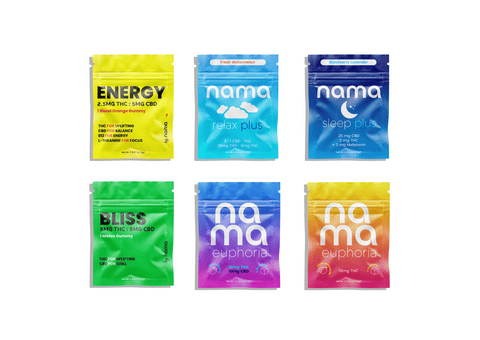
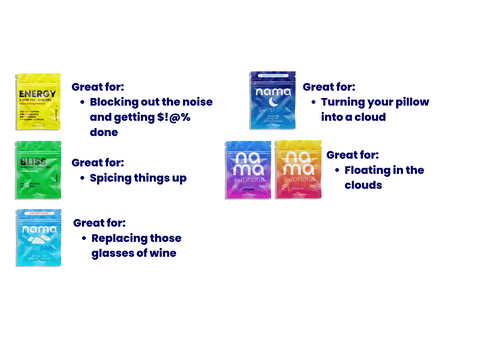
![Buzz Drops™ [THC Drink Drops]](http://www.namacbd.com/cdn/shop/files/nama_thc_buzz_drops.png?v=1711412866&width=480)
![Buzz Drops™ [THC Drink Drops]](http://www.namacbd.com/cdn/shop/files/buzz-drop-wine-comparison.png?v=1736882023&width=480)
![Buzz Packs™ [THC and CBD Powder Drink Mix]](http://www.namacbd.com/cdn/shop/files/nama_buzz_packs_thc_drink_pack_white_background.png?v=1741884660&width=480)
![Buzz Packs™ [THC and CBD Powder Drink Mix]](http://www.namacbd.com/cdn/shop/files/Buzz_Packs_Label.png?v=1741884660&width=480)
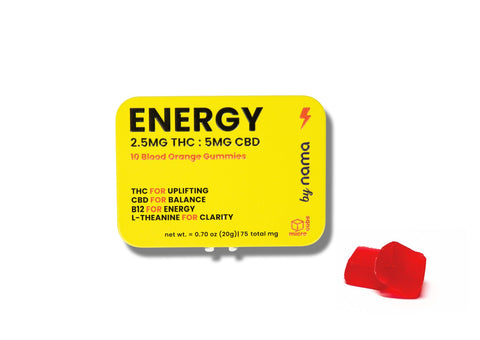
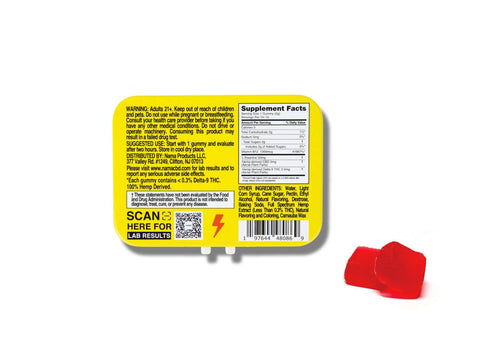
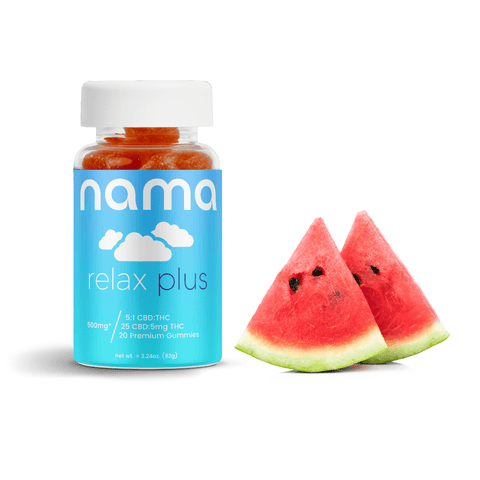
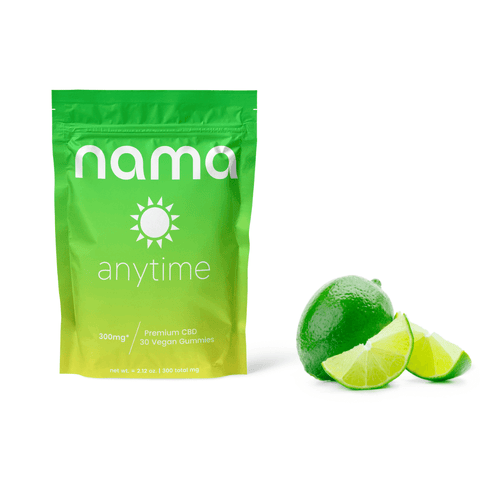
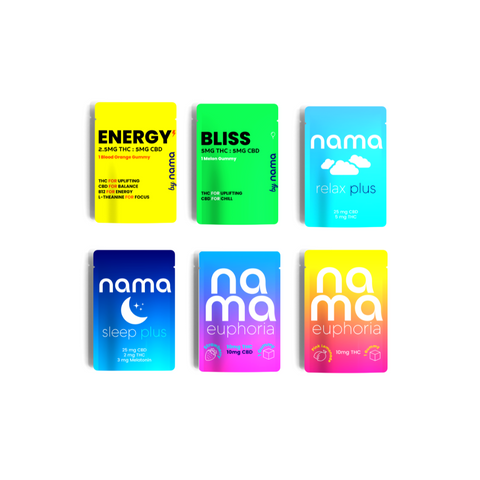
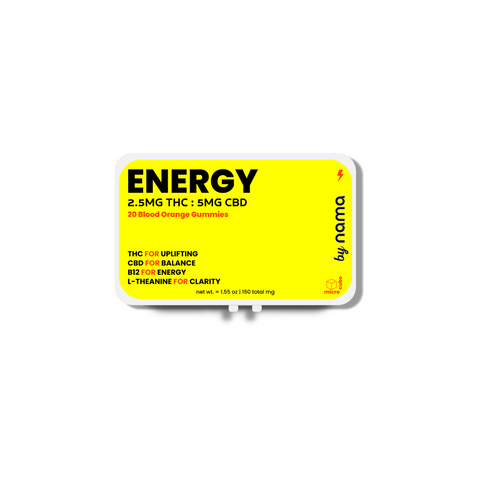

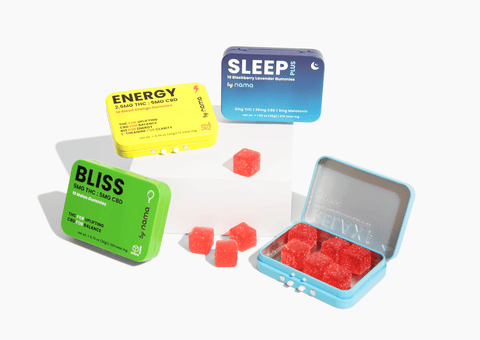
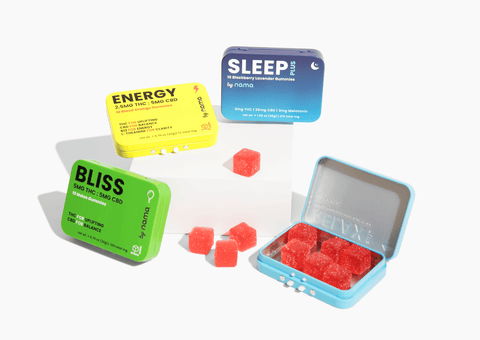
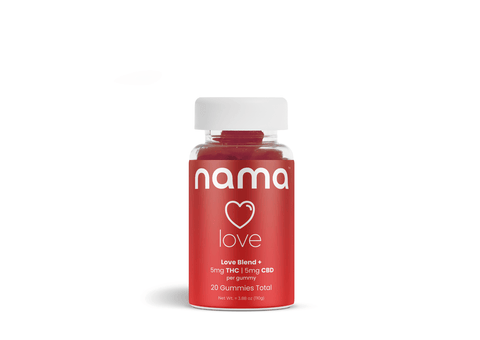
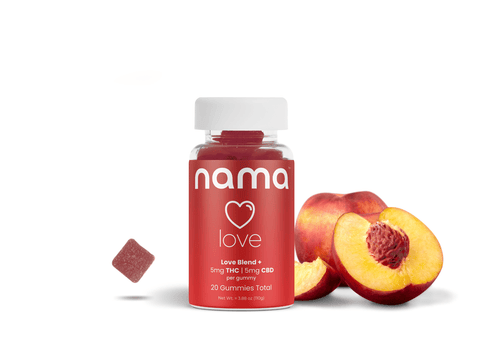
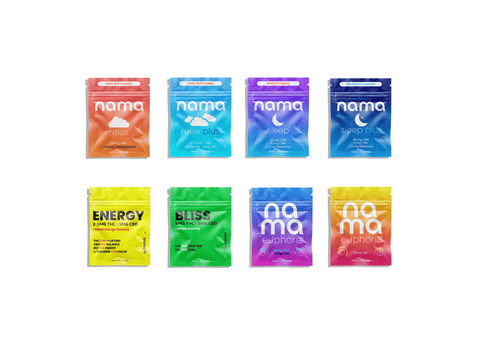

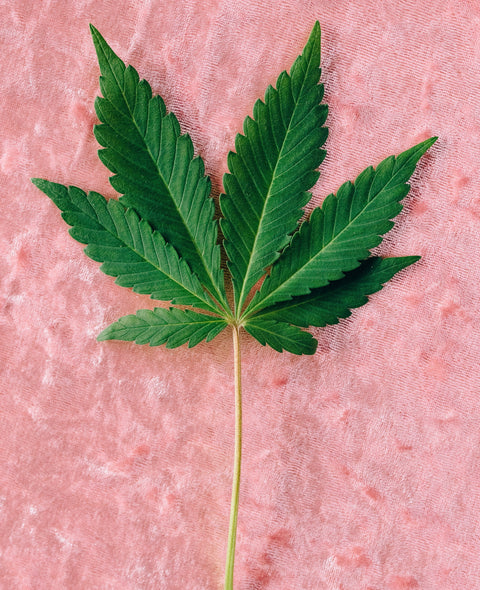
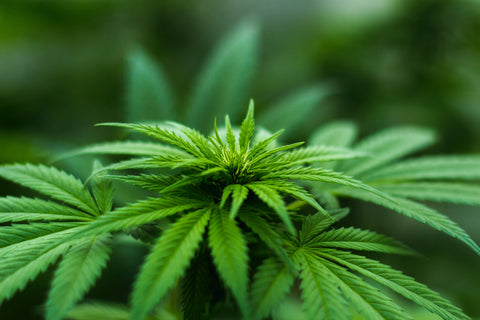

Comments (0)
There are no comments for this article. Be the first one to leave a message!